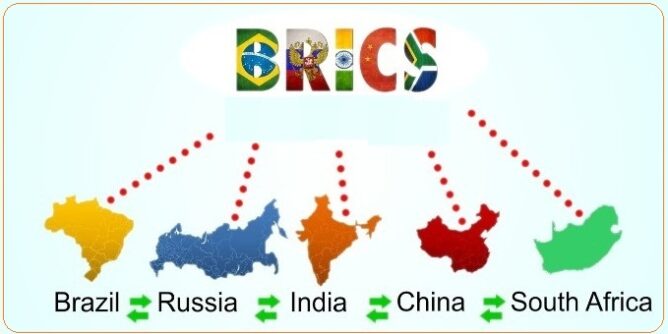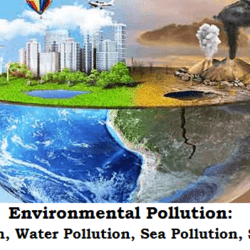
BRICS is a dialogue and cooperation platform of five major emerging national economies: Brazil, Russia, India, China and South Africa (BRICS). Originally the first four were grouped as “BRIC” (or “the BRICs”), before the induction of South Africa in 2010.
This platform aims to promote peace, security, prosperity and development in multi-polar, inter-connected and globalized world. The BRICS countries represent Asia, Africa, Europe and Latin America, which gives their cooperation a transcontinental dimension making it especially valuable and significant.
Background
- The term “BRIC” was coined in 2001 by then-chairman of Goldman Sachs Asset Management, Jim O’Neill, in his publication Building Better Global Economic BRICs.
- The foreign ministers of the initial four BRIC states (Brazil, Russia, India, and China) met in New York City in September 2006 at the margins of the General Debate of the UN General Assembly, beginning a series of high-level meetings.
- A full-scale diplomatic meeting was held in Yekaterinburg, Russia, on 16 June 2009.
- The main reason for co-operation to start among the BRICs nation was the financial crises of 2008.
- The crises raised skepticism on the dollar dominated monetary system and the need for participation by non-G7 countries became evident.
- South Africa was invited to join BRIC in December 2010, after which the group adopted the acronym BRICS. South Africa subsequently attended the Third BRICS Summit in Sanya, China, in March 2011.
Objectives
- This platform aims to promote peace, security, prosperity and development in multi-polar, inter-connected and globalized world.
- The BRICS seeks to deepen, broaden and intensify cooperation within the grouping and among the individual countries for more sustainable, equitable and mutually beneficial development.
- BRICS takes into consideration each member’s growth, development and poverty objectives to ensure relations are built on the respective country’s economic strengths and to avoid competition where possible.
- BRICS is emerging as a new and promising political-diplomatic entity with diverse objectives, far beyond the original objective of reforming global financial institutions.
Potential Additional Membership
Afghanistan, Argentina, Indonesia, Mexico and Turkey have expressed strong interest in full membership of the BRICS, while Egypt, Iran, Nigeria, Sudan, Syria and most recently Bangladesh and Greece have also expressed interest in joining BRICS.
Structure

- BRICS does not exist in form of organization, but it is an annual summit between the supreme leaders of five nations.
- The Chairmanship of the forum is rotated annually among the members, in accordance with the acronym B-R-I-C-S.
- BRICS cooperation in the past decade has expanded to include an annual programme of over 100 sectoral meetings.
| BRICS (Founded: June 2006) Summits |
| 1st Summit: June 2009, Yekaterinburg (Russia) |
| 10th Summit: July 2018, Johannesburg (South Africa) |
| 11th Summit: Nov 2019, Curitiba (Brazil) |
Areas of Cooperation
Economic Cooperation:
- There are rapidly growing trade and investment flows between BRICS countries as well as economic cooperation activities across a range of sectors.
- Agreements have been concluded in the areas of Economic and Trade Cooperation; Innovation Cooperation, Customs Cooperation; strategic cooperation between the BRICS Business Council , Contingent Reserve Agreement and the New Development Bank.
- These agreements contribute to realization of the shared objectives of deepening economic cooperation and fostering integrated trade and investment markets.
Political and Security Cooperation:
- BRICS member political and security cooperation is aimed at achieving peace, security, development and cooperation for a more equitable and fair world.
- BRICS provides opportunities for sharing policy advice and exchanges of best practices in terms of domestic and regional challenges as well as advancing the restructuring of the global political architecture so that it is more balanced, resting on the pillar of multilateralism.
- BRICS is utilized as a driver for South Africa’s foreign policy priorities including the pursuit of the African Agenda and South-South Cooperation.
People-to-People Exchange:
- BRICS members have recognized the need for strengthening People-to-People exchanges and to foster closer cooperation in the areas of culture, sport, education, film and youth.
- People-to-People exchanges seek to forge new friendships; deepen relations and mutual understanding between BRICS peoples in the spirit of openness, inclusiveness, diversity and mutual learning.
- Such People to people exchanges include the Young Diplomats Forum, Parliamentarian Forum, Trade Union Forum, Civil BRICS as well as the Media Forum.
Cooperation Mechanism
Cooperation among members is achieved through:
- Track I: Formal diplomatic engagement between the national governments.
- Track II: Engagement through government-affiliated institutions, e.g. state-owned enterprises and business councils.
- Track III: Civil society and People-to-People engagement.
Significance
- BRICS countries together account for 30% of global land, 43% of global population and 21% of the world’s Gross Domestic Product (GDP), 17.3% of global merchandise trade, 12.7% of global commercial services and 45% of world’s Agriculture Production.
- Together they 13.24% of the World Bank voting power and 14.91% of IMF quota shares.
- With 10 years of development, BRICS has grown into an important platform for cooperation among emerging markets and developing countries.
- BRICS will continue to be an influential voice as long as its convergences prevail over its divergences. At the G20 meetings, the BRICS was influential in shaping macroeconomic policies in the aftermath of the recent financial crisis.
- The BRICS plays a vital role in the world economy in terms of total production, receiving investment capital, and expanding potential consumer markets.
Impacts of BRICS on Global Institutional Reforms
- The main reason for co-operation to start among the BRICs nation was the financial crises of 2008. The crises raised doubts over sustainability of the dollar-dominated monetary system.
- The BRICs called for the “the reform of multilateral institutions in order that they reflect the structural changes in the world economy and the increasingly central role that emerging markets now play”.
- BRICs managed to push for institutional reform which led to International Monetary Fund (IMF) quota reform in 2010. Thus the financial crises had momentarily reduced western legitimacy and briefly let the BRICs countries become “agenda setters” in multilateral institutions.
New Development Bank
- NDB is headquartered in Shanghai and has regional centres in South Africa and Brazil.
- At the Fourth BRICS Summit in New Delhi (2012) the possibility of setting up a new Development Bank was considered to mobilize resources for infrastructure and sustainable development projects in BRICS and other emerging economies, as well as in developing countries.
- During the Sixth BRICS Summit in Fortaleza (2014) the leaders signed the Agreement establishing the New Development Bank (NDB).
- Fortaleza Declaration stressed that the NDB will strengthen cooperation among BRICS and will supplement the efforts of multilateral and regional financial institutions for global development thus contributing to sustainable and balanced growth.
- NDB’s key areas of operation are clean energy, transport infrastructure, irrigation, sustainable urban development and economic cooperation among the member countries.
- The NDB functions on a consultative mechanism among the BRICS members with all the member countries possessing equal rights.
Contingent Reserve Arrangement
- Considering the increasing instances of global financial crisis, BRICS nations signed BRICS Contingent Reserve Arrangement (CRA) in 2014 as part of Fortaleza Declaration at Sixth BRICS summit.
- The BRICS CRA aims to provide short-term liquidity support to the members through currency swaps to help mitigating BOP crisis situation and further strengthen financial stability.
- It would also contribute to strengthening the global financial safety net and complement existing international arrangements (IMF).
Challenges
- Competition within themselves:
- The BRICS countries aspire to be regional powers and hence at some point will compete with each other.
- Different forms of governance:
- They have different political systems with Brazil, India and South Africa being democracies while Russia and China having authoritarian characteristics.
- Trade conflicts possibility:
- Brazil and Russia are commodity exporting countries and thus benefit from high commodity prices while India and China are commodity importers that benefit from low commodity prices
- Territorial Issues:
- China and India have outstanding territorial issues to resolve and India looks suspicious to any institution that has Chinese domination. Russia looks suspiciously at China’s interest in its sparsely populated far eastern of Siberia.
- The big daddy China:
- China spearheads three other major initiatives in this region- One Belt One Road (OBOR), Asian Infrastructure Investment Bank (AIIB) and SCO.
- Limited agenda:
- The BRICS will need to expand its agenda for increasing its relevance in the global order. As of now, climate change and development finance, aimed at building infrastructure dominate agenda.
Importance for India
- India can benefit from collective strength of BRICS by way of consultation and cooperation on economic issues of mutual interests, as well as topical global issues, such as, international terrorism, climate change, food and energy security, reforms of global governance institutions, etc.
- India remains engaged with the other BRICS countries on its NSG membership and UNSC Permanent Seat.
- The NDB will help India to raise and avail resources for their infrastructure and sustainable development projects.
- Through G4 (Brazil, Germany, India and Japan) and through BRICS, India can advocate for reforms in the global multilateral institutions like UNO, IMF, World Bank, WTO, etc.
- BRICS platform would be a catalyst for the rapprochement between India and China and moreover, India can keep the cordial relations with its all weather friend Russia, intact.
- India can use Brazil and South Africa relations as a gateway to expand its relations with South America and Africa respectively.
- BRICS would be a strong neutralizer for India against the growing China-Pakistan-Russia relations.
BRICS Plus
- ‘BRICS Plus’ was first mooted by Chinese Foreign Minister Wang Yi in March 2017 with the objective of widening the “circle of friends” of BRICS that can bring unity among developing countries and enhance South-South cooperation.
- The initiative is aimed at upping the outreach activities of the BRICS countries with the Global South and building wider partnership with emerging markets and developing countries (EMDCs).
- China had initially shown interest in creating a permanent BRICS Plus arrangement. However, there is no consensus within the grouping on getting a permanent set of developing countries as BRICS Plus category.
- The other four member countries (Brazil, Russia, India and South Africa) remain wary of China’s predominance in BRICS and its increasing influence in the Global South.
- Through BRICS Plus, China probably seeks to forge regional and bilateral alliances across the continents, which could also be instrumental in pushing its Belt and Road Initiative (BRI).

 Home
Home Syllabus
Syllabus Contact Us
Contact Us




